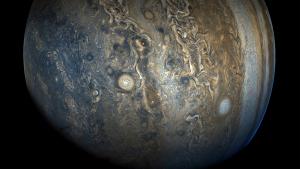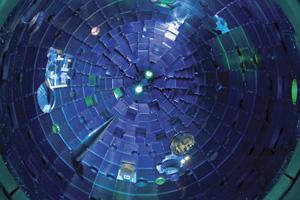LAB REPORT
Science and Technology Making Headlines
Aug. 31, 2018


Five Lawrence Livermore National Laboratory researchers join an eclectic group of entrepreneurs, writers, executives, philanthropists and more in Diablo Magazine’s annual “40 Under 40” list. Clockwise from top left Sarah Baker, Louisa Pickworth, Marcus Worsley, Alicia Williams and Leily Kiani.
40 under 40
Five Lawrence Livermore researchers join an eclectic group of entrepreneurs, writers, executives, philanthropists and more in Diablo Magazine’s annual “40 Under 40” list, which recognizes young professionals in the East Bay who are leading the charge in their fields.
Louisa Pickworth, an experimental physicist and group leader in the Physics Division, works on X-ray diagnostics and inertial confinement fusion at the National Ignition Facility, the world’s largest and most energetic laser; Sarah Baker, a staff scientist and deputy group leader for the Functional Materials Synthesis and Integration Group, works on developing technologies to help mitigate climate change. Leily Kiani, a postdoctoral researcher in the Fiber Technologies Group, explores extending the utility of fiber lasers by increasing the frequency ranges accessible to fiber-based systems; Alicia Williams, a design engineer in the Defense Technologies Engineering Division, strives to ensure a safe and secure nuclear deterrent; and Marcus Worsley, a chemist in the Advanced Materials Synthesis Group, aims to develop novel nanostructured and porous materials, such as aerogels and nanocomposites, for energy and environment-related applications.


New research suggest Jupiter grew slowly during early formation. Photo courtesy of Gerald Eichstädt/Seán Doran/NASA/JPL-Caltech/SwRI/MSSS
Jupiter has growing pains
New research suggests why Jupiter, the largest planet in the solar system, waited about 2 million years for its early formation growth spurt.
A team led by a Swiss researcher found that kilometer-size worlds smashed into the giant planet during that time, generating zones of high energy. This bombardment made it difficult for gas molecules to accrete, forcing the planet to grow more slowly. The new data lined up with a separate set of results that Lawrence Livermore scientist Thomas Kruijer gleaned from observations of meteorite compositions.
Kruijer's team found that the meteorites studied were separated into the inner zone of our solar system, and the outer zone, starting about 1 million years after the solar system formed. The pull of Jupiter, the researchers said, was the reason that material from the outer solar system, where Jupiter and the gas giants reside, could not interact with the inner part of the solar system, where Earth and other rocky planets orbit today.


Bennu is among millions of primitive asteroids composed of molecules that may have been the precursors to life on Earth. Image: NASA's Goddard Space Flight Center Conceptual Image Lab
Welcome to the rock
Back in 2016, NASA launched OSIRIS-REx in a mission to fly to the asteroid Bennu and collect a small sample of the rock’s surface. As of last week, the spacecraft has begun the "asteroid operations" phase of its mission, where it will first take photos of the rock and survey its surroundings for possible hazards.
Bennu has a 1 in 2,700 chance of colliding with the planet we call home. According to Lawrence Livermore, Bennu is a beast of an asteroid in terms of size. It spans more than five football fields in diameter and weighs 1,664 times more than the Titanic. If Bennu hits the Earth, the impact would release 80,000 times the energy of the atomic bomb that struck Hiroshima in 1945. So scientists want to learn more about it and its composition.
For this reason, and because Bennu might contain valuable resources that could be used for a future space exploration mission, NASA sent OSIRIS-REx in 2016 to gather a sample of the rock.


A sample of microarchitectured graphene aerogel, made from one of the lightest materials on Earth, sits atop a flower.
A new way to print graphene aerogel
Lawrence Livermore researchers have developed a way to print complex 3D objects with graphene, creating an aerogel that could be used in numerous industries.
Graphene aerogel is lighter than air but as strong as steel, and it’s already proven useful in aerospace, energy storage and insulation. While there have been recent advances in 3D printing of the novel material, achieving complex structures has been elusive, hampering the unique material’s full potential.
To date, 3D printing of graphene aerogel has been done using direct-ink or other extrusion-based methods, where layers of graphene are squeezed through a nozzle, like toothpaste from a tube. This process has restricted design of parts printed from the ultra-low density material to simple geometries. To overcome this limitation, for two years scientists and engineers at Lawrence Livermore and Virginia Tech have focused on 3D printing graphene aerogel using light, a method known as projection micro-stereolithography.
The team reported a breakthrough, producing micro-architectured 3D graphene aerogel structures with higher resolution and complexity than anything created before with other 3D printing methods. Researchers began pursuing alternative printing methods while working to optimize electrodes for flow batteries.


Unraveling the properties of fluid metallic hydrogen at the National Ignition Facility could help scientists unlock the mysteries of Jupiter’s formation and internal structure. Credit: Mark Meamber/LLNL
Metal that's a gas
Scientists have bombarded hydrogen with 168 powerful laser beams — part of the world’s largest laser, the National Ignition Facility at Lawrence Livermore National Laboratory — to reproduce what happens to the gas under the intense pressures at the cores of giant planets.
What they saw confirms predictions that if you keep hydrogen cool enough while pounding on it with 6 million times atmospheric pressure — twice the pressure at the center of the Earth — the hydrogen turns into a shiny metal.
It’s like squeezing air and turning it into a shiny, light version of liquid mercury. Although exotic at Earth’s surface, metallic hydrogen is the main material inside most giant planets and stars.





